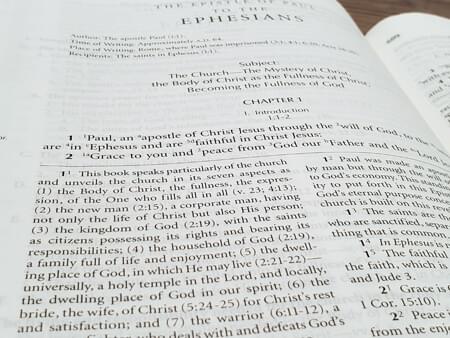In 1974 I began to write the footnotes for the Recovery Version of the Bible. I have written these footnotes to expound the books of the Bible for a few purposes. The main purpose is to bring you into the truth. As of January 1985 we have had trainings over the entire twenty-seven books of the New Testament. [In 1995 he completed the Life-study of the entire Bible.] Those of you who have been trainees in the trainings should have realized that the first purpose of the footnotes of the Recovery Version is to present the truth. I do not believe that you can find as many basic truths in any other books as you have found in the Recovery Version. Other expositions and commentaries, for example, do not correctly point out what the main truth in the book of Matthew is. The Recovery Version clearly points out that this is a book on the kingdom of the heavens, and it gives you a proper definition of the truths concerning the kingdom of the heavens. (Elders’ Training, Book 3: The Way to Carry Out the Vision, ch. 9 [CWWL, 1984 2:310])
In the Lord’s recovery today we enjoy all the major items of the truth—the Bible as the Word of God, the Triune God, the economy of God, the all-inclusive Christ in His full ministry, the Spirit as the consummation of the processed Triune God, the church as the Body of Christ, and the New Jerusalem as the eternal goal of God’s economy. The Recovery Version with the footnotes helps to unlock and unveil all these major truths. For example, read 2 Corinthians 13:14: “The grace of the Lord Jesus Christ and the love of God and the fellowship of the Holy Spirit be with you all.” This verse speaks of the Triune God not in a doctrinal way but in the very experiential way of God dispensing Himself in His Trinity into His chosen and redeemed people. The footnote on this verse, one of the longest footnotes in the Recovery Version, gives us a solid presentation of the truth concerning the Triune God that explains the distinctions within the Trinity and how these distinctions can and should relate to our experience as believers and members of the Body of Christ. Wonderful!

In this footnote, as in several others in the Recovery Version, there is also a succinct yet complete presentation of the full economy of God, beginning from our redemption and salvation to our eternal habitation with God in the New Jerusalem.
Another example is the truth concerning the all-inclusive Christ, who is typified in Deuteronomy 8:7-10 by the abundant riches of the good land that God brought the children of Israel into: “a land of waterbrooks…a land of wheat…a land of olive trees…a land in which you will eat bread without scarcity…a land whose stones are iron.” Footnote 1 in verse 7 explains in detail how Christ fulfills all the types in these verses by showing from the New Testament how He is all-inclusive for our experience and for the accomplishment of God’s purpose. In this footnote, as in several others in the Recovery Version, there is also a succinct yet complete presentation of the full economy of God, beginning from our redemption and salvation to our eternal habitation with God in the New Jerusalem.
The great truth concerning the Spirit is one that has been passed over by many believers over the centuries, but by the Lord’s mercy we in the Lord’s recovery enjoy this truth in all its fullness. The Bible indicates the fullness of this truth through the many titles it has for the Spirit, from Genesis 1 through Revelation 22. In Philippians 1:19 the Spirit is particularly referred to as “the Spirit of Jesus Christ,” and the footnote on this title presents the truth concerning the Spirit in the entire Bible in a clear and concise way. Many of the titles of the Spirit in the Bible are explained in this note and applied to our experience. After reading this footnote, we will easily see how Paul in this verse could speak of the Spirit as our bountiful supply.
Many of the titles of the Spirit in the Bible are explained in this note and applied to our experience.

One of the greatest truths that we have among us today is the full revelation concerning the church from the New Testament, and in the Recovery Version there are several notes that unveil this revelation. The very first footnote in Ephesians (note 1 on 1:1) shows the seven aspects of the church comprehensively. Then, note 2 on Ephesians 4:24 gives an in-depth explanation of the relationship among some of these aspects, focusing on the new man as the new corporate person in which Christ fulfills God’s eternal economy. Note 2 on Ephesians 5:27 opens up the precious truth concerning the church as the bride of Christ for His satisfaction. These are just the main notes on the church to be found in Ephesians, but scattered throughout the entire Recovery Version there are many, many others.
Finally, the aggregate of all the visions and revelations of the Bible, of all the truths and experiences in God’s eternal economy, are consummated in the great vision of the New Jerusalem in Revelation 21 and 22. For millennia these two final chapters of the Bible have been either grossly misunderstood or callously dismissed by most believers. Among us today we have a very high appreciation for this vision of our eternal destiny with God, a mutual habitation of God in man and man in God. The footnotes in these two chapters are rich in explaining the meanings of all the signs to be found in the vision of the New Jerusalem, and these unveilings help us to see in detail how God’s economy throughout the entire Bible flows into and consummates in the New Jerusalem. The very last footnote in these chapters—the last note in Revelation and in the entire Recovery Version—summarizes the meaning of the New Jerusalem and indeed of the whole Bible: “According to the entire revelation of the complete Bible, the New Jerusalem, the conclusion of the complete Bible, is a divine mingling of the processed Triune God with the redeemed and transformed tripartite man, a mingling of divinity with humanity, issuing in a universal, corporate, mysterious person” (note 3 on Rev. 22:21).
The footnotes in these two chapters are rich in explaining the meanings of all the signs to be found in the vision of the New Jerusalem, and these unveilings help us to see in detail how God’s economy throughout the entire Bible flows into and consummates in the New Jerusalem.
These are just some of the notes on the major items of our faith, offered as concrete examples of the first purpose of the Recovery Version with the footnotes—to present the truth. There are many more notes on all these major items as well as notes on many minor aspects of the truth throughout the Recovery Version. For anyone desiring to come to the full knowledge of the truth, the Recovery Version should be first on his or her list of resources.